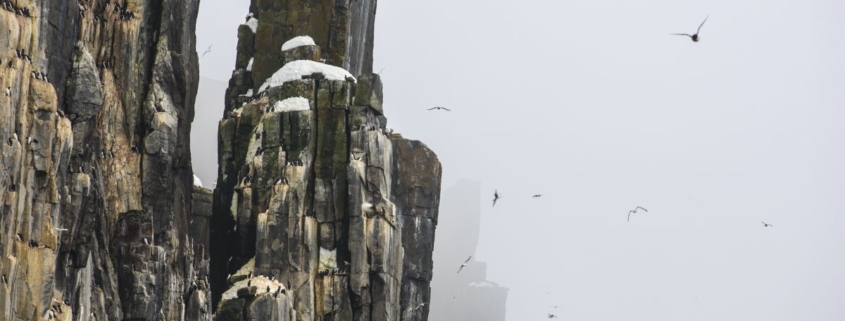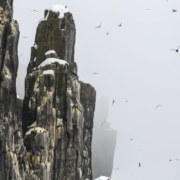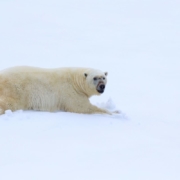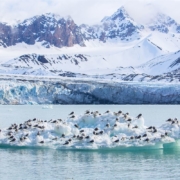Dolomite Cathedral
On our fifth day we entered “Hinlopen Stretet” (Hinlopen Strait). The water was calm, the light was good but nothing prepared me for what was to come. We were told that we would come to a cliff with nesting birds (Alkefjellet – fjellet meaning “mountain”) – namely Brünnich’s guillemots (the penguin of the arctic but NOT actually a penguin which is only found in the southern hemisphere). As we slowly proceeded down the straight, we could hear the sounds of the cliff long before we saw the cliff. And then we came upon Alkefjellet…..wow. There must have been over 100,000 birds flying and nesting on the ledges of this massive Dolomite wall.
The Brünnich’s is the most northerly guillemot and like most auks, is an expert diver and swimmer. The birds were flying and diving around the ship. Guillemot nesting cities are mostly cited along exposed cliffs where they occupy ledges against steep rock walls. This inaccessibility provides protection against polar foxes who predate on their eggs and chicks. This cliff is the most impressive breeding site in the Arctic for guillemots. The ledges become occupied in March and April, and the eggs are laid in May or June as soon as the snow melts. The incubation period is 31 – 34 days roughly and both parents take turns with brooding. The eggs are also pear-shaped which prevents them from falling off the thin rock ledges.
How can one describe a profound experience? Floating next to the cliffs felt like being in an ancient Cathedral built by a master architect from an age long ago – or a holy Monastery where solitude reigns supreme while the souls of nature’s saints take wing and call out to those of us still bound to this earth. We were surrounded by the glory of snowy northern peaks of the Arctic and the calling of tens of thousands of birds swarming from a wall of solid textured rock colored in tones of warm browns.
For me, it was one of those moments when you are thankful to be alive.

~ Jami Tarris






Leave a Reply
Want to join the discussion?Feel free to contribute!